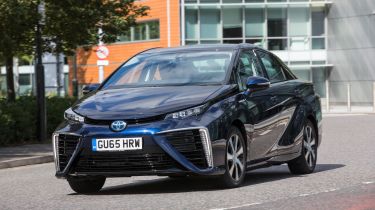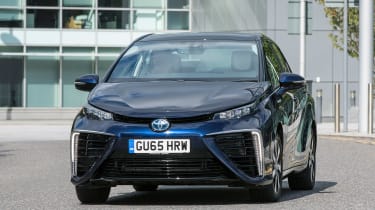Toyota Mirai saloon (2015-2020)
"The Mirai is hugely innovative and good to drive, but its high purchase price and the UK's very limited hydrogen infrastructure excludes all but the most committed early adopters - for now."
Pros
- Innovative hydrogen technology
- Smooth and quiet on the move
- All-inclusive contract hire
Cons
- Very few filling stations
- Cramped in the back
- Hugely expensive
For all the talk of the future of electric cars, it’s easy to forget there’s another way: hydrogen. Due to the technology’s relative complexity and a refuelling infrastructure that’s growing only gradually, the sole hydrogen-powered car currently on sale, the Toyota Mirai, remains a rare sight.
That will inevitably change, though: it’ll be joined by the Honda Clarity FCV in several years’ time and by then the refuelling landscape could be unrecognisable.
Before you dismiss the hydrogen aspirations of Toyota as a pipe dream, remember who pioneered the hybrid car concept and turned the Toyota Prius into the world’s best-selling hybrid. Since then, pretty much every other carmaker has got in on the act.
The Toyota Mirai isn’t a pretty car, but it has been sculpted in such a way to aid mechanical cooling and reduce wind resistance on the move, improving its efficiency. It certainly makes a statement, but it’s easy to see the family resemblance between it and the Prius. It’s a hard to judge the Mirai’s scale, but for comparison, it’s fractionally longer and narrower than a Ford Mondeo.
It’s under that quirky styling where the magic happens. The hydrogen is stored in a tough tank and is fed through a fuel-cell stack, which generates power to feed the batteries, power the motors and turn the wheels.
More reviews
In-depth reviews
You can find out more in our hydrogen cars feature.
You fill up the Mirai is a fairly conventional way, but it’s here where the car currently struggles in the face of ever-improving electric cars and hybrids. There are very few hydrogen filling stations around the country, although there are new ones popping up every now and again – but not nearly quick enough for hydrogen-powered cars to gain much of a foothold.
However, with the government banning the sale of new petrol and diesel cars by 2040, we hope to see some much-needed investment. What is for sure is this won’t happen overnight.
So what does this mean for the Mirai owner?
With a range of around 300 miles on a tank of hydrogen, you need to live or work pretty close to one of the stations for it to be a viable proposition.
If you do, then the Mirai feels like a normal electric car to drive. Its 152bhp and 247lb ft of torque is available as soon as you press the accelerator pedal, meaning it’s extremely nippy around town. Above that, performance is on par with a 2.0-litre non-turbocharged car of a similar size.
It’s also comfortable, with suspension that soaks up bumps well, plus there’s no engine noise and very little wind or tyre roar to break the serenity. Toyota’s use of acoustic glass and foam insulation sees to that.
There’s only one trim level on offer, with standard kit including touchscreen sat nav, heated rear seats, automatic emergency braking and blind-spot monitoring.
So the Mirai wants for very little – and it shouldn’t, considering its price. All that new technology doesn’t come cheap: it costs £66,000, before the government’s £4,500 plug-in car grant has been deducted. You can lease one for £750 a month, which includes servicing, tyres and fuel.
See what this car scored on our sister site DrivingElectric














